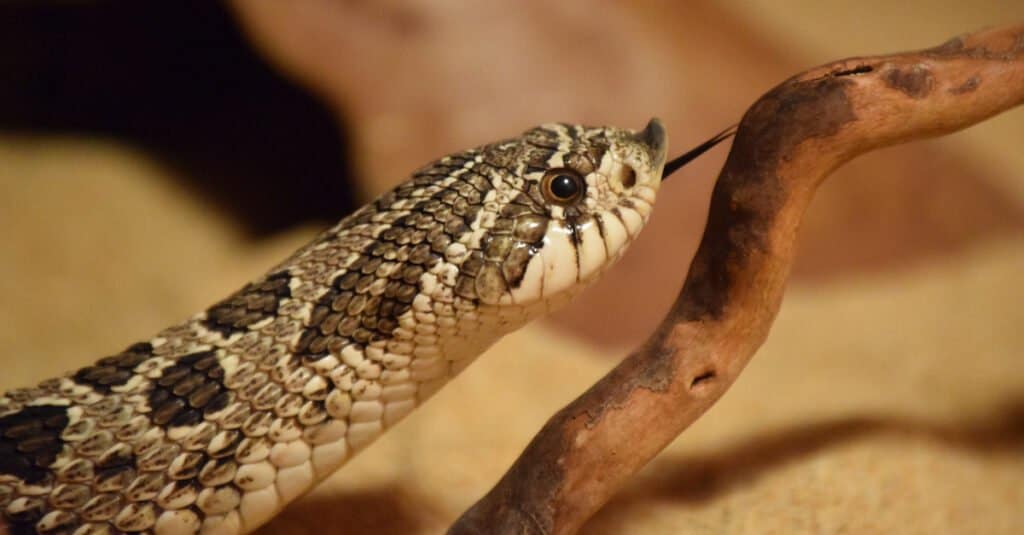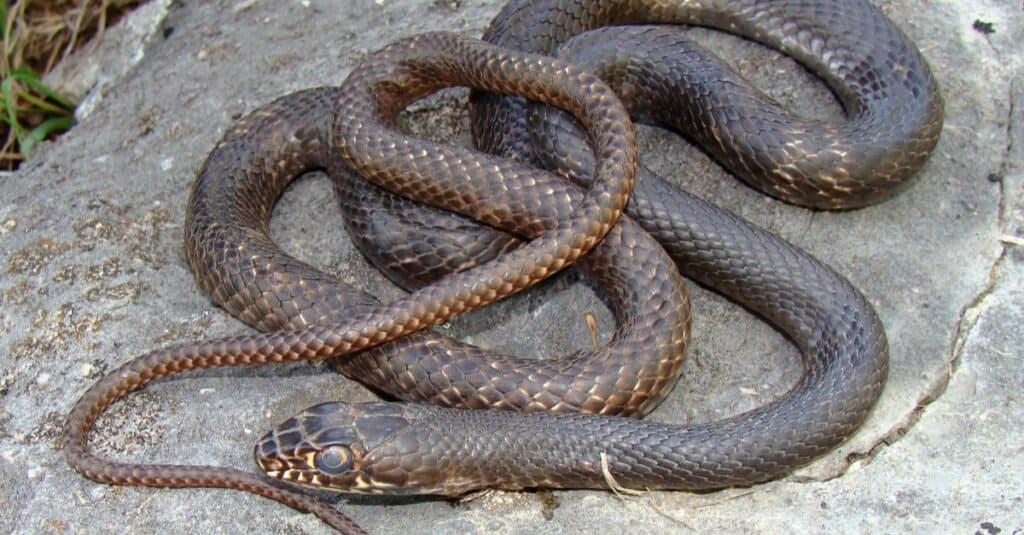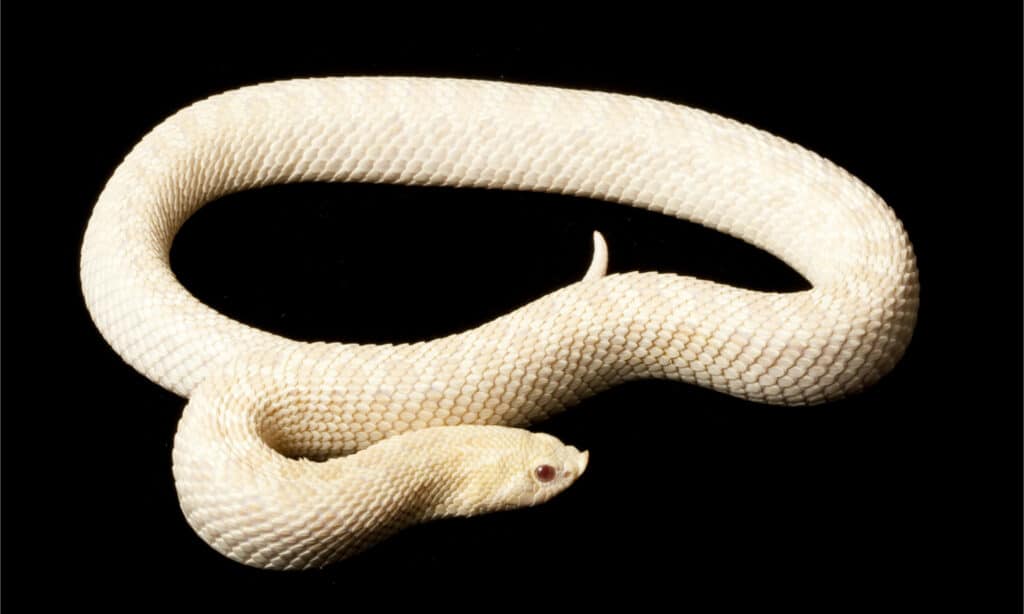The hognose snake and coachwhip snake are two examples of snakes that fake their death as a defensive strategy among different species and subspecies of snakes. They have a lot of differences that can help in telling them apart.
In this article, we take a look at both snakes and highlight their key differences. Let us explore them together.
Comparing Hognose snake vs Coachwhip snake

| Hognose Snake | Coachwhip Snake | |
|---|---|---|
| Max Length | 3 feet | 8 feet |
| Speed | Slow | Fast |
| Elongated Nose Scale | Yes | No |
| Playing Dead | Yes | Yes |
| Appearance | Blotches | Tapering Color |
| Good as a Pet | Yes | No |
The Key Differences Between a Hognose Snake vs Coachwhip Snake
The main differences between hognose snakes and coachwhip snakes are length, speed, appearance, and adaptation as pets.
Hognose snakes are slightly venomous, while coachwhip snakes are nonvenomous. Both snakes play dead, but their defensive postures differ before resorting to death feigning.
Let’s discuss all of these differences in more detail below.
Hognose Snake vs Coachwhip Snake: Their Faces

Hognose snakes have a protruding scale on their nose to help them find food and dig burrows.
©Bryn Thomas/Shutterstock.com
Hognose snakes have a protruding scale on their nose for digging through dirt, sand, and debris. They use it to look for food, find an inconspicuous place to sleep, and dig burrows.
While coachwhip snakes are also on the hunt for burrows and prey, they do not have a special scale for digging. Their heads are rather small, and their nose is rounded and slender than the rest of the head.
Both snakes have round pupils and big eyes, typical of most nonvenomous snakes.
Hognose Snake vs Coachwhip Snake: Venom
Hognose snakes are a little venomous, though it poses little threat to a human. The venom isn’t injected by fangs and instead is administered by back teeth. The back teeth pierce their victim, and their toxic saliva enters the prey’s body and kills them.
Hognose snake’s venom is mainly used to incapacitate toads, though some varieties prefer fish and other small creatures. Even when they attack out of self-defense, they tend not to bite unless things get dangerous for them.
Coachwhip snakes are wholly nonvenomous, but they chew when they bite with tiny sharp teeth in their mouth. These teeth are designed to direct prey straight down the throat once captured.
Hognose Snake vs Coachwhip Snake: Death Feigning
Both the hognose snake and the coachwhip snake fake their deaths when their more aggressive behaviors used as a deterrent don’t work. As a last resort, they pretend to be dead.
Flipping over on its back, the hognose snake writhes while emitting a disgusting musk and defecating. It then may shutter and go completely still. It will remain like this even if it is picked up, poked, or otherwise bothered.
Coachwhip snake will also try to fight by holding its head up and striking, but it plays dead if that doesn’t work. The hognose snake also puts up much of the same stinky act – they both do this hoping that the threat will leave them alone.
If the hognose snake is flipped over and its belly is no longer exposed, it will roll around and continue its death feigning act the entire time with its mouth agape.
Hognose Snake vs Coachwhip Snake: Defensive Posture
When cornered or threatened, the hognose snake tries to look more like a cobra or other venomous snakes by flattening its neck and breathing in and out heavily. Interestingly, its ability to do this has led to studies into whether the hognose snake snores.
Coachwhips take a different approach to threats by raising their heads like they would while looking for prey. Both will repeatedly bite during an attack.
Hognose Snake vs Coachwhip Snake: Their Diet
Hognose snakes like to eat small prey like amphibians, eggs, rodents, and lizards. The coachwhip’s diet is almost identical to the hognose snake’s diet, but like both snakes, what’s available in the region determines which animal they are eating.
Hognose Snake vs Coachwhip Snake: Habitat

Coachwhip snakes live in America.
©Matt Jeppson/Shutterstock.com
While the hognose snake lives all over the Americas and in Madagascar, the coachwhip snake is found solely in America. Some of these snakes have overlapping ranges with suitable habitats for both snakes.
Coachwhip snakes prefer sandy and loose soil and often hang around in prairies, dunes, fields, and open forests. These snakes like to be out during the hottest part of the day. Hognose snakes are so varied that they live in a multitude of environments.
Coachwhips like underground burrows as their hibernation space, just like hognose snakes.
Hognose Snake vs Coachwhip Snake: Appearance
The coachwhip snake has geometric scaling that resembles a woven whip used to drive horses when coaches were the main form of transportation. That’s how the coachwhip got its name.
The coachwhip snake doesn’t have a color pattern. Rather, its color is a gradient across its body, with the head being the darkest and the tail being the lightest. This tapering color is different depending on which coachwhip we’re discussing, with most being black and white while some are shades of red, pink, brown, and other colors.
Hognose snakes have lighter bodies and darker blotches on their body. They also come in various colors, though both snakes tend to match the habitat in which they live. Some kinds of hognose snakes only exist in captivity.
Hognose Snake vs Coachwhip Snake: Keeping as a Pet

The snow hognose snake is bred in captivity.
©fivespots/Shutterstock.com
There are a lot of hognose snakes in captivity that are rarely if ever, seen in the wild. One example is the snow hognose snake that is almost completely white. It is known as one of the least aggressive snakes one can own and make a great pet for beginners because the enclosure it needs is small.
Hognose snakes don’t really bite in nature and prefer to headbutt and then play dead. This works out well with these snakes when handling them. They also acclimate to being handled well.
On the other hand, coachwhip snakes don’t make good pets because they are prone to bite when handled. They’re also extremely hard to tame if found in the wild. While some experienced handlers keep them as pets, they’re not recommended for the average reptile enthusiast.
The photo featured at the top of this post is © Mark_Kostich/Shutterstock.com
Discover the "Monster" Snake 5X Bigger than an Anaconda
Every day A-Z Animals sends out some of the most incredible facts in the world from our free newsletter. Want to discover the 10 most beautiful snakes in the world, a "snake island" where you're never more than 3 feet from danger, or a "monster" snake 5X larger than an anaconda? Then sign up right now and you'll start receiving our daily newsletter absolutely free.
Thank you for reading! Have some feedback for us? Contact the AZ Animals editorial team.






